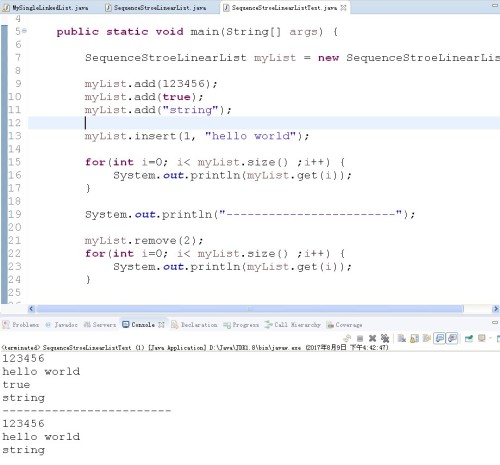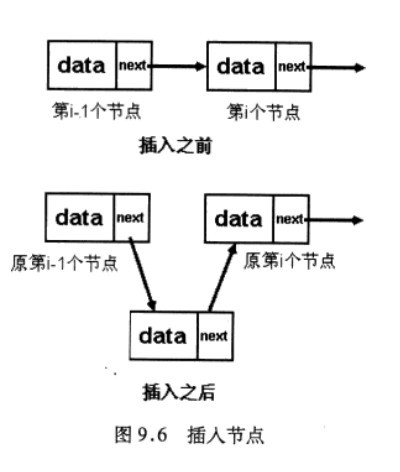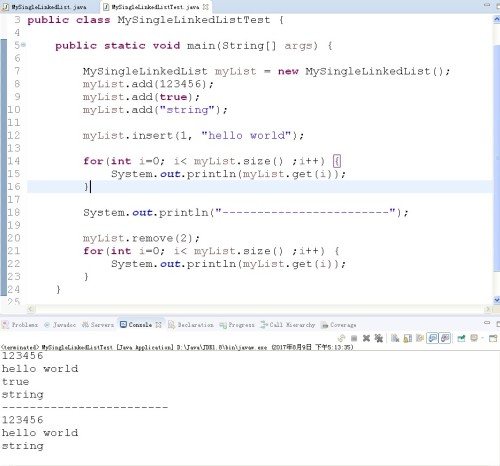java學習筆記--類ArrayList和LinkedList的實現
阿新 • • 發佈:2017-08-10
java 集合 list
在集合Collection下的List中有兩個實現使用的很頻繁,一個是ArrayList,另一個是LinkedList,在學習中肯定都會有這樣的疑問:什麽時候適合使用ArrayList,什麽時候用LinkedList?這時,我們就需要了解ArrayList和LinkedList的底層的實現,下面,為了更好的了解它們具體是怎樣實現的,我們來寫自己的ArrayList 和LinkedList。
ArrayList底層是基於數組實現的,數組在內存中是存儲在連續的存儲單元中,在數據查找的時候比較快,適用於不常進行插入數據和需要頻繁的查找數據的操作,下面,我們將其實現(為了方便理解,不使用泛型,用Object存儲數據):
import java.util.Arrays;
/**
* 順序存儲結構:類ArrayList的實現
* @author liuzb
* 2017年8月8日 下午2:58:59
*/
public class SequenceStroeLinearList{
/**
* 用於存儲容器中實際存儲的元素個數
*/
private int size = 0;
/**
* 底層用於存儲數據的容器
*/
private Object[] container;
/**
* 在順序存儲結構中,用於初始化
*/
private static final Object[] EMPTY_CONTAINER = {};
/**
* 構造器,用於初始化存儲數據的容器
*/
public SequenceStroeLinearList(){
this.container = EMPTY_CONTAINER;
}
/**
* 構造器,用於初始化存儲數據的容器
*/
public SequenceStroeLinearList(int minCapactiy) {
if(minCapactiy > 0) {
container = new Object[minCapactiy];
}else if(minCapactiy == 0) {
container = EMPTY_CONTAINER;
}else {
throw new ArrayIndexOutOfBoundsException();
}
}
/**
* 向容器中添加一個元素
* @param index 添加元素位置
* @param element 待添加元素
*/
public void insert(int index ,Object element) {
//要向一個數組中插入數據:1、數組的長度夠不夠 2、插入位置合不合法
//如果插入位置不合法,拋出索引越界異常
if(index > container.length || index <0) {
throw new ArrayIndexOutOfBoundsException();
}else {
//插入位置合法
//如果是在尾部插入數據
if(index == container.length) {
container = Arrays.copyOf(container, ++size);
container[index] = element;
}else {
//如果不是在尾部插入數據,先用臨時變量存儲容器中的內容
Object[] temp = container;
//1、container指向一個新容器
container = new Object[size+1];
//將原數組的下標從0到index的元素復制到擴容後的容器中
System.arraycopy(temp, 0, container, 0, index);
//2、將index及其以後位置的數據整體向後移位
for(int i = size ; i > index ; i--) {
container[i] = temp[i-1];
}
//3、插入數據
container[index] = element;
//4、元素個數加一
++size;
}
}
}
/**
* 向容器中添加數據
* @param obj 需要添加的對象
*/
public void add(Object obj) {
insert(size,obj);
}
/**
* 容器中實際存儲的元素個數
* @return
*/
public int size() {
return size;
}
/**
* 獲取指定索引位置的對象
* @param index 指定位置的索引
* @return 指定位置的對象
*/
public Object get(int index) {
if(index <0 || index > size) {
throw new ArrayIndexOutOfBoundsException();
}
return container[index];
}
/**
* 獲取指定對象的索引
* @param obj 需要獲取索引的對象
* @return 索引
*/
public int indexOf(Object obj) {
int index = -1;
for(int i = 0; i<size ; i++) {
if(container[i].equals(obj)) {
index = i;
}
}
return index;
}
/**
* 容器中是否包含某個元素
* @param obj
* @return false 不包含 true 包含
*/
public boolean contains(Object obj) {
return indexOf(obj) == -1 ? false :true;
}
/**
* 從容器中移除指定索引的元素
* @param index 需要移除元素的索引
* @return 移除
*/
public boolean remove(Integer index) {
boolean flag = true;
// 非法索引,拋出異常
if (index < 0 || index > size) {
flag = false;
throw new ArrayIndexOutOfBoundsException("移除指定索引元素失敗,索引值非法");
} else {
// 索引合法
for (int i = index; i < size-1; i++) {
//將index到size的元素依次往前移位
container[i] = container[i + 1];
}
// 將末尾元素值賦為 null
container[size-1] = null;
// 元素個數減一
-- size;
}
return flag;
}
/**
* 移除指定元素
* @param obj 需要移除的元素
* @return true :移除成功 false:移除失敗
*/
public boolean remove(Object obj){
if(contains(obj)) {
remove(indexOf(obj));
return true;
}
return false;
}
}在實現中,用到了util包下面的Arrays幫助類,此處也可以使用System.arrayCpy()。
寫好該類後,對該類進行測試:

從實現結果看,我們基本實現了ArrayList的功能,此處重要的兩個方法是插入數據和移除數據,當然本程序也有bug,就是remove方法。
LinkedList底層是基於鏈表實現的,在數據插入和刪除時速度較快,適用於頻繁進行插入和刪除的操作, 這裏我們實現一個單鏈表:
這裏我們實現一個單鏈表:
/**
* 自定義鏈式存儲列表 :單鏈表
* @author liuzb
* 2017年8月9日 上午11:24:07
*/
public class MySingleLinkedList {
/**
* 單鏈表中的首節點
*/
private Node header;
/**
* 單鏈表中的尾節點
*/
private Node tail;
/**
* 單鏈表中實際存儲元素的個數
*/
private int size;
/**
* 內部類,用於封裝節點需要的數據和下一個節點的地址
* @author liuzb
* 2017年8月9日 上午11:24:43
*/
private class Node{
/**
* 當前鏈表存儲的數據
*/
private Object data;
/**
* 當前節點存儲的下一個節點的地址
*/
private Node next;
/**
* 無參構造器,用於節點的初始化
*/
public Node() {
}
/**
* 有參構造器,用於節點的初始化
* @param date 節點存儲的值
* @param next 節點中保存的下一個節點的地址
*/
public Node(Object data,Node next) {
this.data = data;
this.next = next;
}
/**
* 獲取當前節點的存儲的值
* @return 節點值
*/
public Object getData() {
return data;
}
}
/**
* 單鏈表頭插入法
* @param item 需要存儲的數據
*/
public void addHeader(Object item) {
//定義一個節點
Node node = null;
//如果原鏈表是空表
if(size == 0) {
//構建一個新的節點,節點的下一個節點指向null
node = new Node(item,null);
//頭結點和尾節點都指向新節點
header = node;
tail = header;
}else {
//如果原鏈表不是空表,定義一個新節點,新節點的下一個節點指向原來的頭結點
node = new Node(item,header);
//新節點變成了頭結點
header = node;
}
//元素的個數加一
size ++;
}
/**
* 單鏈表為插入法
* @param item 需要出入的元素
*/
public void addLast(Object item) {
//創建一個新節點
Node node = new Node(item,null);
// 如果原來的鏈表是空表
if(size == 0) {
//單鏈表的頭結點和尾節點都指向新節點
tail = header = node;
}else {
//原來的尾節點的下一個節點指向新節點
tail.next = node;
//新節點變成了尾節點
tail = node;
}
//鏈表的元素個數加一
size ++;
}
/**
* 向單鏈表中添加元素
* @param item 待添加的元素
* @return
*/
public void add(Object item) {
//方法中默認使用尾插入法插入元素
addLast(item);
}
/**
* 移除指定位置的元素
* @param index 需要移除元素的索引
* @return true:移除成功 false:移除失敗
*/
public boolean remove(int index) {
boolean flag = false;
//如果索引非法,拋出異常
if (index < 0 || index >= size) {
throw new IndexOutOfBoundsException("移除元素的索引越界");
} else {
//如果移除的是頭結點
if (index == 0) {
//原頭結點的下一個節點變成了頭結點
header = header.next;
}else if(index == size-1) {
//如果刪除的是尾節點,先獲取原尾節點的前一個節點
Node node = getNodeByIndex(index-1);
//將原尾節點的前一個節點存儲的下一個節點地址信息置為null
node.next = null;
//原尾節點的前一個節點變成了尾節點
tail = node;
}else {
//刪除的既不是頭結點,也不是尾節點,將需要刪除的數據先暫時存儲
Node removeNode = getNodeByIndex(index);
//獲取需要刪除數據的前一個節點
Node node = getNodeByIndex(index - 1);
//將前一個節點的下一個節點指向需要刪除的節點的下一個節點
node.next = removeNode.next;
}
//元素個數減一
size -- ;
flag = true;
}
return flag;
}
/**
* 獲取指定索引的節點
* @param index 需要獲取的節點的索引值
* @return 節點對象
*/
public Node getNodeByIndex(int index) {
Node current = header;
for(int i = 0;i < size && current != null;i++) {
if(index == i) {
return current;
}
current = current.next;
}
return null;
}
/**
* 獲取單鏈表中元素個數
* @return 元素個數
*/
public int size() {
return size;
}
/**
* 獲取指定索引的節點值
* @param index 需要獲取的節點的索引
* @return 節點值
*/
public Object get(int index) {
//索引非法,拋出異常
if(index < 0 || index >= size) {
throw new ArrayIndexOutOfBoundsException("無法獲取該節點的值");
}
return getNodeByIndex(index).getData();
}
/**
* 向鏈表指定位置插入數據
* @param index 待插入位置
* @param item 待插入數據
* @return true 插入成功 false 插入失敗
*/
public boolean insert(int index,Object item) {
boolean flag = true;
if(index < 0 || index >size) {
flag = false;
throw new ArrayIndexOutOfBoundsException();
}
//如果插入到頭結點前
if(index == 0) {
header = new Node(item,header);
}else if(index == size) {
//插入到尾節點後
//定義一個新的節點
Node node = new Node(item,null);
//尾節點的下一個節點指向新節點
tail.next = node;
//新節點變成了尾節點
tail = node;
}else {
//在首節點和尾節點之間插入節點
//獲取出入位置的節點
Node indexNode = getNodeByIndex(index);
//定義新節點,新節點的下一個節點指向原插入位置的節點
Node newNode = new Node(item,indexNode);
//獲取插入位置的前一個節點
Node node = getNodeByIndex(index-1);
//插入位置的前一個節點的下一個節點指向新節點
node.next = newNode;
}
//元素個數加一
size ++ ;
return flag;
}
}寫好代碼後,對代碼進行測試:

以上是個人拙見,如有錯誤,請指出,謝謝!
本文出自 “劉紫兵的博客” 博客,請務必保留此出處http://zibing.blog.51cto.com/8177516/1954864
java學習筆記--類ArrayList和LinkedList的實現
